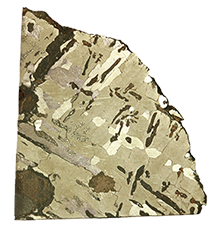
The fall of this meteorite might have been observed in May of the Year 1516 during the reign of the Chinese Emperor Zhengde. ("During summertime in May of Jiajing 11th year, stars fell from the northwest direction, five to six fold long, waving like snakes and dragons. They were as bright as lightening and disappeared in seconds.") The meteorites laid untouched until 1958 when there was a great need for iron for the growing industrialization of China. It was found that the meteoritic iron contained too much nickel for smelting. The fall has been estimated at 9.5 metric tons, covering an area of more than 8 km wide and a length of 27 to 28 km between the towns of Lihu and Yaochai, located NE and ESE of Nandan, respectively. The largest fragment is a mass of 2000 kg. This specimen has been etched to show its beautiful 3-D Widmanstaetten pattern.


